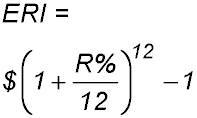Where the techniques of Maths
are explained in simple terms.
Financial Maths - Two other commonly used concepts to describe interest rates.
Comparison rate and the Effective Annual interest rate.
- Algebra & Number
- Calculus
- Financial Maths
- Functions & Quadratics
- Geometry
- Measurement
- Networks & Graphs
- Probability & Statistics
- Trigonometry
- Maths & beyond
- Index
| On this page, the discussion is organised into the following sections: |
| 1. Comparison rate. |
| 2. Effective interest rate. |
| 3. Strategy for calculation. |
| 4. When is the rate used? |
When taking out a loan, the basic information you require includes:
- How much can I borrow?
- What interest rate will I be paying?
These figures are provided readily by the lender. Later in a discussion, other costs should be revealed including:
- establishment fees - costs incurred by the lending organisation to establish your loan;
- monthly account fees to cover costs of processing the regular payments and general monitoring of the loan;
- other periodic fees (depending of the lender) and also a possible fee paid at the end of the loan period.
When these additional costs are taken into account, the amount to be repaid increases. So too does the interest rate on the basic amount borrowed because there is now more to repay in the same time period.
Hence an advertised interest rate of 5% may increase to (say) 5.1% to cover the additional charges.
As lending agencies have different amounts for their costs to be charged, a comparison rate is required to facilitate the comparison between lenders. In addition, the difference between the advertised interest rate and the comparison facilitates better understanding by potential borrowers of the implications of the loan being offered.
A comparison rate does not however include all potential charges. For example, Government charges such as Stamp Duty are not included. Nor are optional fees such as a fee for paying out a loan before the agreed time of fees for altering the loan provisions.
If you are borrowing to buy something, you might look for a lower comparison rate. If you are investing money, you might look for a higher comparison rate.
Nevertheless, a Comparison Rate does give a consumer a general understanding of the additional costs involved over and above the basic advertised rate.
A second term used to compare interest rates is the Effective Annual Interest Rate.
This rate is used frequently in advertisements for buying any type of goods from household products to vehicles as well as buying houses and property.
The term generally distinguishes between:
- the nominal interest rate which is sometimes the simple interest rate and at other times the compound interest rate without consideration to the compounding periods;
- the effective annual interest rate incorporates the effects of compounding the investment and as well takes into account any fees which are charged.
So the effective interest rate is the real return on an investment.
Example:
Two investments are advertised for 1 year periods with the same nominal interest rate of 5%:
Option A: 5% per annum compounded monthly;
Option B: 5% per annum compounded six monthly.
Option A rate is calculated as 
Option B rate is calculated as 
Option A has the higher effective interest rate because there are more compounding periods.
So here, the nominal interest rate of 5% p.a. is increased to an effective interest rate of 5.12% when compounded monthly.
Consider investing an amount for one year in two different accounts:
| Invested in a simple interest account for one year: | Invested in an account with interest compounded monthly: | |
| Interest rate: | r % p.a. (This is the nominal rate of interest) |
R % p.a. compounded monthly. (This is the nominal rate of interest). |
| Number of periods in one year: | 1 | 12 |
| Effective rate of interest calculation: | No calculation - the ERI is just r%. |  |
Both of these calculations estimate the interest rate - not the amount of interest received.
Note that the more frequently interest is paid - and so the larger the number of interest payments made in a year - the higher is the effective interest rate.
In the above examples, the 5.12% rate was achieved with 12 compounding period in 12 months while the lower rate of 5% only had interest paid at the end of 12 months.
The actual amount of interest received is calculated in the normal way for simple and compound interest.
The compounding component implies that the nominal rate will always be less than the effective rate.
For an investment, a company always wants to make it appear that it is offering the best possible rate. Hence the effective rate of interest would generally be advertised for an investment rather than the stated annual rate of return - or the nominal rate.
For a loan, a company wants to appear to offer the lowest rate and so will advertise the nominal (or stated annual return) rate with details of the compounding period less prominent. In such situations, the comparison rate might be more revealing.